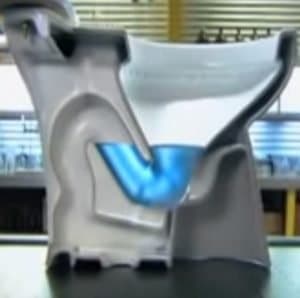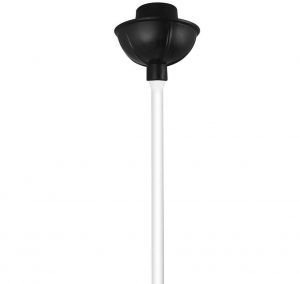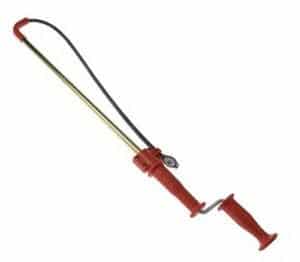How to Fix a Toilet That Bubbles/Gurgles – When Flushed
Last Updated on July 28, 2023 by toilethaven
Why Does a Toilet Bubble When Flushed?
A toilet bowl is designed to retain water at the P-trap’s bottom. This water is a barrier preventing sewer gases/smells from entering your bathroom.
When your toilet bubbles/gurgles every time you flush it, it is a sign that either the drainpipe or vent stack is clogged or the septic tank is full. This creates negative air pressure inside the pipes, which is forced out through the toilet bowl water in air bubbles, sometimes with a gurgling sound.
A bubbling/gurgling toilet should be fixed as soon as possible, as it is a sign of a bigger problem waiting to happen. If your toilet bubbles when flushed, your waste is not flowing out but is building up in the drainpipe.
Every time you flush the toilet, it displaces air out of the pipe, which escapes through the bottom of the toilet in air bubbles.
If a toilet bubbling when flushed is not fixed in good time, it will lead to a backup. A backup happens where instead of the toilet channeling the waste into the city’s sewer lines, it flows back to your toilet, bathtub drain, sink drain, or any other drain in the house.
How a Toilet Works

Toilets depend on gravity to flush, which is why the water tank is placed above the bowl. When you flush the toilet, a large volume of water is released into the bowl forcefully in a short period.
This sudden water dumping into the bowl causes a pressure differential between the bowl and the drainpipe. This pressure imbalance initiates the siphoning of the waste into the toilet drainpipe. The waste, therefore, flows through the drain and into the city’s sewer lines. Read more on how a toilet works here.
A small amount of water flows into the toilet bowl from the tank. This is the water at the bottom of the toilet bowl, which prevents sewer gases from entering the bathroom and the entire house.
The sewer gases instead move up the vent stack and escape through the house’s roof. If the vent stack is blocked, the air will have no way of moving out and, therefore, will force its way through the toilet bowl, which results in a bubbling toilet after flushing.
How to Isolate a Toilet That Bubbles After Flushing
A house has a network of drainpipes from the toilets, sinks, laundry rooms, and bathtubs, which all link up into the main house drainpipe before flowing out to the sewer line and finally into the city sewer line.
Before you start fixing a toilet that bubbles/gurgles when flushed, you need to be sure whether it is only the toilet that is clogged or the entire house drainage is clogged.
The following are some of the signs to look out for:
1. Bathtub Drain Gurgles When Toilet is Flushed
If the house’s main drainpipe is clogged and you flush the toilet, the toilet waste will have to displace the air in the drainpipe since it can’t flow out. The air displaced, just like electricity, will follow the path with the least resistance, which in this case is the bathtub drain and hence the gurgling as the air escapes.
It is easier for the air to escape through the bathtub drain than the toilet bowl since the water at the bottom of the bowl will act as a barrier.
2. Toilet Bubbles when Bathtub drains
A bathtub and toilet drain are connected to the main house drain pipe. If, while draining a bathtub, you notice your toilet bubbling/gurgling, it is a sign that the house’s main drain is clogged.
Open the bathtub water faucet and let it drain as you watch inside the toilet bowl. If you notice any bubbles, the problem extends beyond your toilet drain.
If the tub drains as usual without any bubbling in the bowl, the problem is, therefore, with your toilet drain. This is a much easier problem to resolve.
3. Toilet on a Septic Bubbles When Flushed
If you use a septic tank and notice that your toilet bubbles when you flush it, it means either the septic tank is full or the drainpipe to the septic is clogged.
If the tank is full, you undoubtedly need to empty it, but a clogged drainpipe can be easily unclogged either by yourself or a plumber.
4. Talk to Your Neighbors
Plumbers are not cheap. Before you, therefore, enlist the services of one, take your time to talk to your neighbors to see if they have the same problem as you do.
The city’s sewer lines may be blocked; in this case, they should be responsible for unclogging them. You see, being cool with your neighbors has its advantages.
How to Fix a Toilet That Bubbles/Gurgles When Flushed
If, after investigating, you find out that it is not only your toilet drain that is clogged but rather the entire house, the best idea is to call in a professional plumber. Some people will advise you to remove the main sewer cleanout plug and snake the toilet from there.
Why is it a bad idea to try and do this on your own? The whole house’s waste has been piling up inside the main drainpipes for some time. This means that the waste inside the drainage is under pressure.
If you go ahead and remove the plug, you will have sewage spilling all over your property. It is, therefore, bad advice to do it and will cost you so much more in the end.
If, however, the bubbling toilet problem does not involve other house drains, you can troubleshoot it. There are 4 methods to do it:
1. Unclog the Toilet Using a Toilet Plunger

A toilet plunger is a rubber cup with a stick to unclog toilets. It works by creating a pressure differential between the clog and the bottom of the clog where the pressure below the clog is less than the exerted pressure resulting in the clog being sucked inside the drainpipe.
A plunger also works by sucking the clog into the bowl. Invest in a good plunger that will fit properly on the opening at the bottom of the toilet to create a good seal.
To plunge correctly, ensure your first plunge is gentle as you properly engage the plunger on the toilet opening. Once it is properly engaged, go ahead and plunge hard. Hopefully, the clog will be dislodged, and the toilet will stop bubbling.
To check if the problem is solved, flush the toilet again and see if it bubbles/gurgles. If successful, then well and good. If not, move to the following method. More on how to use a toilet plunger here
2. Unclog the Toilet Using a Toilet Auger

A toilet auger or a plumber’s snake is a long cable with a head and a cranking handle used to unclog toilets by shredding the clog into smaller pieces or pulling them out. Unlike a plunger, the snake goes inside the toilet trap and into the drainpipe, acting directly on the clog if it’s within reach.
Most toilet augers are between 3 to 6 feet, but professional plumbers often use motorized augers, which can exceed 100 feet. Again, if you can’t unclog a toilet with the standard auger, you should call in a plumber because if the clog is too deep in the drainpipe, they might have to remove the toilet.
A standard toilet auger, however, works most of the time. Flush the toilet and see if the toilet is still bubbling or if the problem is resolved. Check out this post to learn how to use a toilet auger without scratching your toilet bowl.
If this also does not work out, you still have one more thing to try.
3. Check and Unclog the Vent Stack
You never know how important a vent is until it gets clogged and sewer gases back up in your kitchen sink drain, bathtub drain, or toilet that bubbles when flushed. Your entire house will smell like a sewer.
When your toilet vent stack is clogged, sewer gases get trapped inside the vent stuck, resulting in the building up of negative air pressure. When the pressure is more than the toilet bowl water barrier can contain, it starts escaping through the water in the form of bubbles, hence the gurgling.
To unclog a blocked vent stack, climb up to the top of the roof of your house with a garden hose using a ladder. Check if you can see the clog from the top or reach it with your hand. Sometimes it is a bird’s nest, dry leaves, or trapped dead rodents/birds.
If you cannot see or remove anything with your hand, use the garden hose to pour water down the vent stack. The water, with the help of gravity, will wash the clog down the drainpipe.
While climbing to the roof, have someone hold the ladder down for you to avoid slipping.
4. Call a Plumber
Experience is everything, so your plumber will charge you upwards of $150 to fix the problem. The plumber has experienced such issues before and has many tools that you might not have at your disposal, and it makes sense to bring one on board if you can’t seem to resolve the problem on your own.
Conclusion
A toilet that bubbles when flushed can be an easy thing to fix or a complicated one. It can also deteriorate into a nightmare if left unfixed. Therefore, The best thing is to fix a bubbling toilet as soon as you detect the problem or when your other house drains are gurgling when the toilet is flushed.
FAQs
1. Why does my bathtub fill when I flush the toilet?
The toilet and bathtub drain is connected to the main house drain. If the main house drain is clogged, the waste is trapped in the drainpipes, building up pressure. When you flush your toilet, the trapped water air and water back up through the bathtub or other drains in the house. Sometimes you can also hear the bathtub drain gurgling when you flush the toilet.
2. Can you flush broken glass down the toilet?
No. Broken glasses cannot be siphoned by the toilet, and even if they are siphoned, they will clog the toilet at the trap or further down in the drainpipe. That will end up being a costly repair.
3. Can you flush drinks down the toilet?
Yes. Drinks are liquids and can flow down the toilet drain easily without clogging. The drink should, however, be flushed without broken glasses or crushed cans. These will surely clog the toilet.
4. Why is my toilet tank bubbling after flushing?
Bubbles in the toilet tank indicate air in the water lines. This is also characterized by a sputtering sound as the toilet refills. To remove the air in the pipes, flush the toilet repeatedly until all the air comes out.
5. Why is my toilet bubbling and won’t flush?
The toilet is clogged either close to the toilet drain opening or a little further down in the drain, which works against the siphoning action of the toilet. Try using a plunger to unclog the toilet; if unsuccessful, upgrade to a toilet auger/snake.